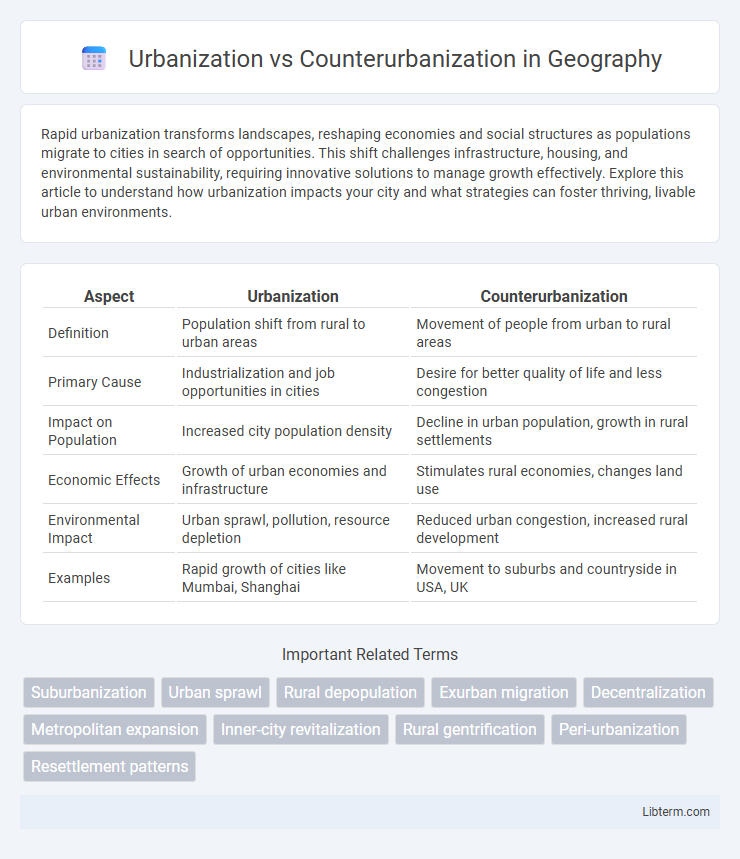Rapid urbanization transforms landscapes, reshaping economies and social structures as populations migrate to cities in search of opportunities. This shift challenges infrastructure, housing, and environmental sustainability, requiring innovative solutions to manage growth effectively. Explore this article to understand how urbanization impacts your city and what strategies can foster thriving, livable urban environments.
Table of Comparison
| Aspect | Urbanization | Counterurbanization |
|---|---|---|
| Definition | Population shift from rural to urban areas | Movement of people from urban to rural areas |
| Primary Cause | Industrialization and job opportunities in cities | Desire for better quality of life and less congestion |
| Impact on Population | Increased city population density | Decline in urban population, growth in rural settlements |
| Economic Effects | Growth of urban economies and infrastructure | Stimulates rural economies, changes land use |
| Environmental Impact | Urban sprawl, pollution, resource depletion | Reduced urban congestion, increased rural development |
| Examples | Rapid growth of cities like Mumbai, Shanghai | Movement to suburbs and countryside in USA, UK |
Understanding Urbanization: Definition and Drivers
Urbanization refers to the increasing concentration of populations in cities due to factors like industrialization, employment opportunities, and improved infrastructure. Key drivers include rural-to-urban migration, economic development, and modernization that attract people seeking better living standards and services. Understanding these dynamics helps explain trends in city growth and the challenges of managing urban expansion.
The Rise of Counterurbanization: What’s Fueling the Trend?
The rise of counterurbanization is fueled by increased remote work capabilities, allowing people to live further from city centers without sacrificing employment opportunities. Quality of life improvements, such as lower living costs, reduced pollution, and access to green spaces, drive migration toward suburban and rural areas. Technological advancements in digital infrastructure support this shift by enabling seamless connectivity and access to services outside traditional urban environments.
Historical Perspectives on Population Movement
Historical perspectives on population movement reveal that urbanization surged during the Industrial Revolution as rural populations migrated to cities for factory jobs, driving unprecedented city growth. In contrast, counterurbanization gained momentum in the late 20th century when advancements in transportation and telecommunications allowed people to move from congested urban centers to suburban or rural areas seeking improved quality of life. These shifts reflect economic transformations and technological progress shaping demographic patterns over time.
Economic Impacts: Urban Growth vs. Rural Revival
Urbanization drives economic growth through increased job creation, higher productivity, and expanded markets in metropolitan areas, leading to stronger industrial and service sectors. Counterurbanization stimulates rural revival by diversifying local economies, promoting small businesses, and enhancing real estate values in less urbanized regions. The interplay between urban growth and rural revival shapes regional development patterns and resource allocation, influencing overall economic resilience.
Social Consequences of Shifting Populations
Urbanization leads to increased social diversity, enhanced cultural exchange, and expanded access to services but can also strain infrastructure and exacerbate inequality in urban areas. Counterurbanization promotes community cohesion and improves quality of life by reducing overcrowding and fostering closer social networks in rural or suburban settings. Both processes impact social dynamics, influencing employment opportunities, housing affordability, and social mobility within changing population patterns.
Environmental Effects: Urban Sprawl vs. Rural Development
Urbanization drives significant environmental changes through urban sprawl, leading to habitat loss, increased air and water pollution, and higher carbon emissions due to expanded infrastructure and transportation demands. Counterurbanization promotes rural development, often resulting in the conversion of natural landscapes for residential and agricultural use, which can disrupt ecosystems but may reduce pressure on densely populated urban centers. Balancing these dynamics requires sustainable planning to minimize ecological footprints while supporting demographic shifts.
Infrastructure Challenges and Opportunities
Urbanization drives rapid infrastructure expansion demands, straining transportation, housing, and utility systems in metropolitan areas, often leading to traffic congestion and resource shortages. Counterurbanization presents opportunities to revitalize rural infrastructure, promoting sustainable development through improved broadband access and decentralized energy systems. Balancing infrastructure investment between growing cities and emerging peri-urban areas ensures resilience and equitable resource distribution.
Technology’s Role in Shaping Migration Patterns
Technology has revolutionized urbanization by enhancing connectivity, enabling remote work, and providing access to digital infrastructure that attracts populations to cities. Conversely, advances in communication technology and high-speed internet facilitate counterurbanization as individuals relocate to rural or suburban areas without sacrificing employment opportunities or social interactions. The proliferation of smart city technologies and digital services continues to influence migration patterns by reshaping the balance between urban growth and suburban or rural resurgence.
Policy Responses to Urbanization and Counterurbanization
Policy responses to urbanization emphasize sustainable city planning, infrastructure expansion, and affordable housing to accommodate growing urban populations and mitigate congestion. In contrast, counterurbanization policies often focus on revitalizing rural areas by improving connectivity, enhancing local services, and promoting economic diversification to attract residents and reduce urban overdependence. Both approaches require integrated spatial planning and targeted investment to balance population distribution and ensure regional development.
Future Outlook: Balancing Urban and Rural Populations
Future urbanization trends point to increased smart city developments integrating sustainable technologies to manage population density and resources efficiently. Counterurbanization is gaining momentum as remote work and digital infrastructure improvements enable more individuals to relocate to rural areas without sacrificing connectivity or economic opportunities. Achieving a balanced population distribution requires strategic planning policies promoting affordable housing, transportation networks, and equitable access to services across both urban and rural environments.
Urbanization Infographic

 libterm.com
libterm.com